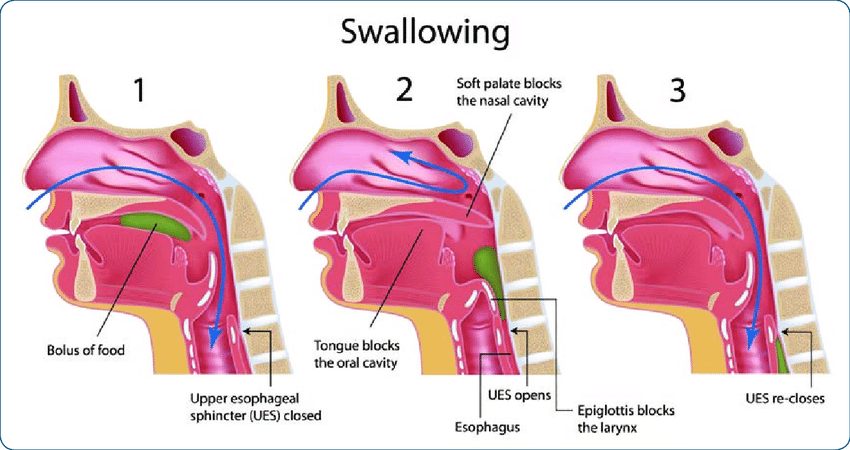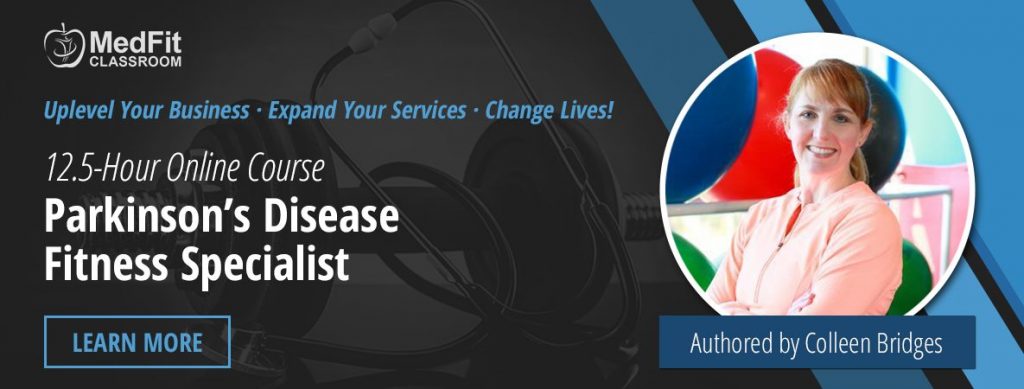The Dark Side of Parkinson’s Disease: The FACE of Parkinson’s Disease, Part 2
Click to read part 1 of this article, covering background on facial masking, swallowing, vocal issues for people with PD.
As a fitness professional, you can help. The key is is knowing how to appropriately apply facial, swallowing and vocal projections drills to private and group sessions. Below are some tips to utilize with your “fighters”.
Occupational Therapy Tips
Decreased facial expression
- Practice recognizing emotions in other people and creating appropriate responses. These responses may include facial expressions and verbal communication. Practicing these reactions to others can help support relationships.
- The word, “affect” refers to the appearance of emotion through facial expressions, voice tone, and body language or gestures. If you have trouble with facial expressions, try to express yourself more through adding gestures or body language when you communicate.
- Communicate your situation! Try explaining your trouble with facial expressions and decreased voice volume to people who may not initially understand.
- Facial exercises:
- look in the mirror and practice your facial expressions.
- hold a smile, raise your eyebrows as high as you can, bring your eyebrows together to frown, open your mouth as wide to stretch your jaw, close your eyes tightly and open them wide, close your mouth and expand your cheeks, stick your tongue out and stretch it in each direction
- Try to exaggerate your facial expressions and lip movements when you speak
Drooling
When eating:
- Try to maintain good posture
- Focus on keeping your chin up and lips closed when eating
- Swallow often to limit saliva
- Avoid sugary foods that create more saliva
Lip closure exercises:
- Close lips tightly for 5 seconds and release (5 times)
- Close lips around tongue depressor and hold while trying to pull from mouth for 5 seconds (5x)
- Fill your cheeks with air and move the air from cheek to cheek (5×5 times)
Dysphagia (Swallowing)

Transferring food from a utensil to the mouth, chewing the food then swallowing and most likely socializing all at the same time without any problems is a task most people take for granted. According to Dr. Jose Vega MD, PhD, three phases must occur in order to swallow properly.
- The Oral Phase: This phase begins when food is placed in the mouth and moistened with saliva. Moistened food is called a food bolus.
- The Pharyngeal Phase: As the food bolus reaches the pharynx, special sensory nerves activate the involuntary phase of swallowing.
- The Esophageal Phase: As food leaves the pharynx, it enters the esophagus, a tube-like muscular structure that leads food into the stomach due to its powerful coordinated muscular contractions. The passage of food through the esophagus during this phase requires the coordinated action of the vagus nerve, the glossopharyngeal nerve, and nerve fibers from the sympathetic nervous system.
Difficulty swallowing as it pertains to PD, reflects a deficiency of dopamine in the brain and often improves with medication and therapy/exercises. Drooling is also a symptom and is caused by reduced reflexive swallowing not from an overproduction of saliva but tends to improve with dopamine replacement therapy. I have come to learn over the years that tremors and swallowing problems are usually the reason someone living with PD isolates themself. It is embarrassing to finally get food on your utensil only to get it to your mouth and realize it has scattered all over the place or fear of aspiration which by the way may not always be heard. Aspiration can be quiet and lead to aspiration pneumonia, the leading cause of death in PD.
Care-partners and Fitness Professionals need to recognize the signs of aspiration as noted below.
Coughing Before/After Swallowing
- Trouble chewing
- Pocketing food inside the cheek
- Gagging during a meal
- Crying or face turning red while eating
- Drooling especially during meals
- Clearing the throat before/after and throughout the day
- Hoarse during and after the meal
For this reason, Coaches at Bridges For Parkinson’s offers popsicles to our “fighters” at the end of class. And they love it! They can have a fun treat without the fear of dropping food and visit with others so it is a win-win! Plus, it allows us to make sure they are hydrated. Sneaky, sneaky!
If a person living with Parkinson’s Disease or their care-partner is not sure whether their loved one has a swallowing issue, the Parkinson’s Foundation provides some great questions to help determine the answer:
- Have I recently lost weight without trying?
- Do I tend to avoid drinking liquids?
- Do I get the sensation of food being stuck in my throat?
- Do I drool?
- Is food collecting around my gum line?
- Do I cough or choke before, during or after eating or drinking?
- Do I often have heartburn or a sore throat?
- Do I have trouble keeping food or liquid in my mouth?
ORAL EXERCISES to help with strengthening and coordinating the LIPS
- Pucker up and blow a “oooo” then transition to an “EEEEEE” (SMILE BIG!)
- “MMMM” press lips together as much as possible and take a deep breath in and hum.. good for the lungs too.
- “Blowfish Hold” and hand isometrically pushes into cheek
TONGUE- ROM, Coordination and strength to help with eating and drinking
- Stick tongue out as far as possible and hold it there (add SPOON FOR RESISTANCE)
- Stick tongue out and up and hold (ADD SPOON FOR RESISTANCE)
- Stick tongue into sides of cheek (helps with food deposits)
- Roll tongue back and press against roof of mouth
In addition to swallowing exercises, meal prep aids in reducing issues brought on by dysphagia and may lower the risk of aspiration. The APDA Organization recommends the following nutritional information:
- Foods that don’t require vigorous chewing. Avoid dry and crumbly foods.
- Moderately textured wheat breads instead of very coarse, nutty breads or very soft, white breads.
- Oatmeal, cream of wheat or moistened dry cereals instead of coarse, dry cereals.
- Well-cooked, tender chicken/turkey, well-cooked fish without bones, chopped and ground meats, instead of stringy, tough meats that require a lot of chewing.
- Soft casseroles and poached or scrambled eggs
- Mashed potatoes or rice, moistened with gravy or margarine, instead of wild rice or French-fried potatoes.
- Soft, cooked pasta elbows, instead of long spaghetti.
- Soft, well-cooked vegetables, cut up or creamed, instead of raw vegetables or those with a hard texture.
- Pureed or mashed fruits, fruit juices and fruit sauces, instead of fruits with seeds or hard outer skins. Avoid nuts, seeds or coconut.
- Custard, yogurt, ice cream or other soft desserts
Speech
The article begins with a story of a grandmother experiencing dysphagia, hypomimia and hypophonia (softness of voice). But people living with PD are not limited to hypophonia when it comes to speech problems. Dysarthria and tachyphemia are additional speech issues people living with PD may experience.
Hypophonia or softness of voice is a condition that the Davis Phinney Foundation states 90% of people living with PD will experience. Characteristics of hypophonia include raspy voice, low speech volume, breathy and/or monotone speech.
Dysarthria is another speech issue related to PD. It is characterized by poor articulation, respiration and/or phonation according to the National Aphasia Association. Speech will come across as slurred, effortful and can often be mistaken for inebriated. Doctors encourage people living with PD who are still driving to wear a bracelet to help law enforcement know they are not drunk.
Tachyphemia or acceleration of speech is also related to speech issues. A person struggling with tachyphemia will sound like all their words are jumbled together and often feel like their tongue is twisted.
While these issues are troublesome and frustrating, there are some easy and even fun ways to combat low volume, slurred and accelerated speech.
- Music Therapy – therapy defined broadly by the American Music Therapy Association as “a treatment including creating, singing, moving to, and/or listening to music [through which] clients’ abilities are strengthened and transferred to other areas of their lives.” All over the country, Parkinson’s Choirs are using singing to help improve respiration, Swallowing and enhanced volume and clarity of voice.
- Breathing Drills- Strong lungs reduces risk of pneumonia and allows the person to complete ADL’s with little to no complications.
- LSVT LOUD: an effective speech treatment for people with Parkinson’s disease (PD) and other neurological conditions. A study on hypophonia in PD reviewed the effectiveness of LSVT treatment for those with idiopathic PD and found that voice loudness significantly improved. Goals include: increased voice volume, improved articulation, increased confidence with communication, and changes in neural function related to speech (https://n.neurology.org/content/60/3/432)
- Speak Up For Parkinson’s App: Yes, an app with exercises that also provides visual feedback on volume.
Exercises
- Breathe in and exhale on a vowel for 5 seconds.
- Hum for 3 seconds making sure to press the lips together then have the “fighter” say….
Their favorite food or movie or color. - Hum for 3 seconds then say the vowels, sliding the voice from one vowel to the next.
- Recite a poem with various emotions.
- Partner “fighters” and have them share jokes with each other. Whoever laughs the hardest wins!
- Close class or a session with a short song or team phrase .
Fitness Professionals have the unique opportunity to incorporate exercises for the face, voice and swallowing while also performing strength and/or cardio exercises. You do not have to separate the two. It is a great way to challenge the cognitive aspects and the physical, all while having fun! The best part is it creates a community moment which deepens their love and trust for you, the fitness professionals. You are making a difference!’
Co-authored by Colleen Bridges, M. Ed, NSCA-CPT; Renee Rouleau-B.S., PhD student, Jacobs School of Biomedical Sciences, University at Buffalo; Kristi Ramsey, OTD, OTR/L.
References
- ParkinsonsDisease.net (Emily Downward)
- Mayo Clinic
- https://neurologicalsurgery.in/top-facial-exercise-for-parkinsons-patient/
- https://www.mottchildren.org/health-library/hw81637
- https://www.urmc.rochester.edu/encyclopedia/content.aspx?contenttypeid=135&contentid=376
- https://n.neurology.org/content/60/3/432
- Ricciardi, L., De Angelis, A., Marsili, L., Faiman, I., Pradhan, P., Pereira, E. A., Edwards, M. J., Morgante, F., & Bologna, M. (2020). Hypomimia in Parkinson’s disease: an axial sign responsive to levodopa. European Journal of Neurology, 27(12), 2422-2429. https://doi.org/https://doi.org/10.1111/ene.14452
- Mäkinen, E., Joutsa, J., Jaakkola, E., Noponen, T., Johansson, J., Pitkonen, M., Levo, R., Mertsalmi, T., Scheperjans, F., & Kaasinen, V. (2019). Individual parkinsonian motor signs and striatal dopamine transporter deficiency: a study with [I-123]FP-CIT SPECT. Journal of neurology, 266(4), 826–834. https://doi.org/10.1007/s00415-019-09202-6
- Adrienne Wootton, Nicola J. Starkey & Carol C. Barber (2019) Unmoving and unmoved: experiences and consequences of impaired non-verbal expressivity in Parkinson’s patients and their spouses, Disability and Rehabilitation, 41:21, 2516-2527, DOI: 10.1080/09638288.2018.1471166
- National Institute of Diabetes and Digestive and Kidney Diseases. Your digestive system & how it works.
- Finsterer J, Grisold W. Disorders of the lower cranial nerves. J Neurosci Rural Pract. 2015;6(3):377-391. doi:10.4103/0976-3147.158768
- National Institute on Deafness and Other Communication Disorders. Dysphagia.


